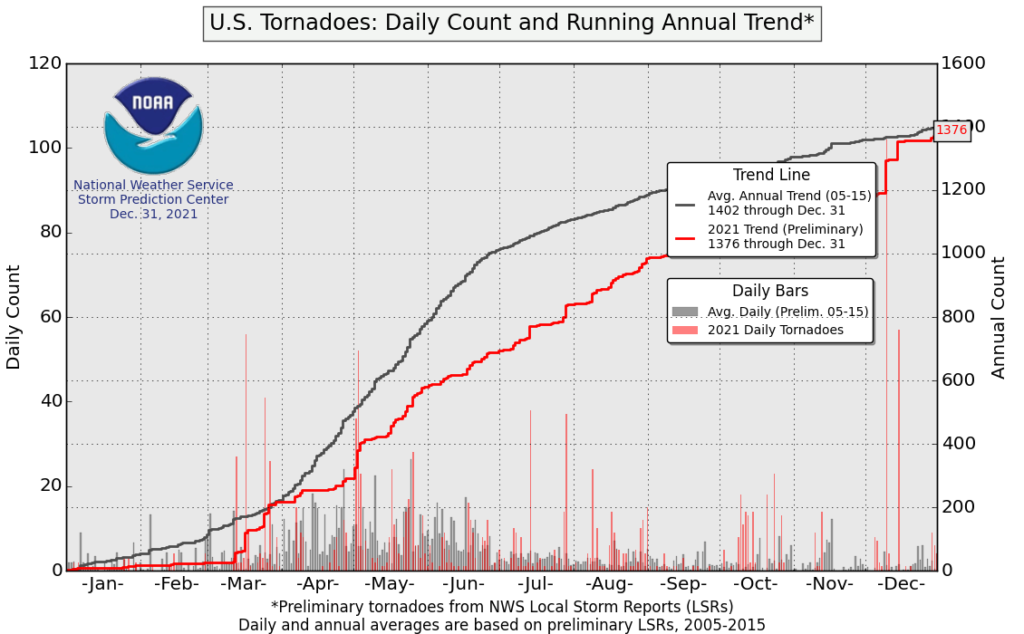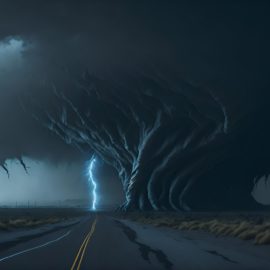
We seem to be getting more tornadoes and December seems to be a draw, or is it?
With dozens of tornado warnings issued Tuesday and Wednesday by National Weather Service offices in Slidell, Lake Charles and Shreveport, including a handful of on-the-ground storms that resulted in three deaths and untold damages, it’s no wonder some folks are asking whether there’s been an upswing in the number of tornadoes occurring in December in Louisiana. But several meteorologists who study tornadoes and severe weather events said Thursday that it’s difficult to see proof of a December uptick in the number of twisters in Louisiana. The midweek outbreak, rather, was indicative of a rare but not unprecedented winter combination of cold air from Canada meeting warm Gulf air, this time in Louisiana. Louisiana State Climatologist Barry Keim says December is not the prime time of the year for tornadic activity in Louisiana, and data dating back to 1991 from the Storm Prediction Center bears that out. Keim says similar outbreaks can occur at any time of the year, and even the most unusual don’t really represent some sort of trend. “Last December, there were 232 tornadoes across the eastern United States, which shattered the previous record of 99 in 2002,” he said. But, as the 19 years between those active years indicates, those totals may still very well be anomalies, rather than a trend.
nola.com

Canada was the blame for the tornadoes as the cold air came from there.
What led to the tornado outbreak in Louisiana on Tuesday and Wednesday, he said, was a typical breakout of a Canada air-fed cold front dipping all the way to south Louisiana, where it met up with a buildup of warm, moist air fed by humidity streaming north from the Gulf of Mexico. “The cold, dry air goes on a march towards the Gulf Coast through this big funnel created by the Rocky Mountains to the west and the Appalachians to the east,” he said. “The only thing to stop that Canadian air is barbed-wire fences.” In Louisiana, the low pressure frontal system dragging the air down collided with the warm, moist tropical air, and then was turbocharged by an upper air jet stream that created the uplift and instability needed to create tornadoes, Keim said. And even though the national statistics do indicate an increase in reported tornadoes, modern technology and social media get some of the blame for the uptick. “In the last five or six years, there has been a tendency to see an increasing number of reports of tornadoes throughout the year,” said Bill Bunting, chief of forecast operations at the National Severe Storms Center in Norman, Oklahoma. “But we think the increase actually is the result of a new ease of reporting tornadoes, the use of iPhones, cameras and videos.”
Technology has made it easier to get information as we used to have to go to newspapers.
It wasn’t that long ago, he said, that the count of tornadoes relied on searches of print newspapers and less accurate radar systems. The other factor, Bunting said, is that more people and objects — homes, shopping centers, large buildings — are now in the pathway of tornadoes than 20 or 50 years ago. The result is that both tornado strikes, and the damage they cause, are becoming more expensive. Less clear, he said, is whether individual tornadoes or trends of their creation are being affected by global warming. “Because our record of quality information for tornadoes is so short, so uneven, it’s hard to say,” Bunting said. “Studies show warming could be causing instability needed to form tornadoes in the atmosphere to increase. But vertical wind shear and changes of wind speed at height might decrease. So we just don’t know.” Harold Brooks, a senior scientist with the National Severe Storms Laboratory and co-author of a 2018 study that indicated there might be an eastward shift of the Texas-Oklahoma “tornado alley” to a more southeastern location for long-path tornadoes, said Louisiana and New Orleans are actually a bit southwest of where that trend was spotted. But Brooks also pointed out that it’s difficult to attribute individual events, like this week’s tornadoes, to any sort of trend. “Although it’s tempting to associate the warming of the planet with the changes we reported in the paper, based mostly on the timing of warming and report changes, we don’t have a complete physical linkage that runs from the warming of the planet to tornadoes,” he said.
An interesting comparison.
He compared the temptation to view individual events as a trend to his own bowling record as a graduate student. “My average was about 150. One night, in the second game of the series, I got a 220. Did that mean that all the practice and league play had made me much better? Perhaps, but the 111 in the next game made me doubt it. Perhaps the tornadoes of this week are my 220 and next year will be my 111.”
I think urban sprawl is part of the problem as there is more to be damaged.



